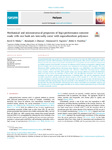Mechanical and microstructural properties of high-performance concrete made with rice husk ash internally cured with superabsorbent polymers

View/
Use this link to cite
http://hdl.handle.net/2183/32276
Except where otherwise noted, this item's license is described as Atribución-NoComercial-SinDerivadas 3.0 España
Collections
- Investigación (ETSECCP) [826]
Metadata
Show full item recordTitle
Mechanical and microstructural properties of high-performance concrete made with rice husk ash internally cured with superabsorbent polymersDate
2022Citation
Nduka, D. O., Olawuyi, B. J., Fagbenle, E. O., González-Fonteboa, B. (2022). Mechanical and microstructural properties of high-performance concrete made with rice husk ash internally cured with superabsorbent polymers. Heliyon, 8(9), e10502.
Abstract
[Abstract:] An experimental study was carried out to determine the properties of rice husk ash (RHA) and its effect on high-performance concrete's (HPC) mechanical and microstructural properties. RHA content was placed at 0–30% at 5% step intervals and a constant water-binder ratio (W/B) of 0.3. A slump flow test was carried out to measure the workability property of the fresh HPC. In contrast, the influence of RHA contents on compressive, splitting tensile, flexural strengths and microstructural properties were examined for the hardened HPC specimens. The X-ray fluorescence (XRF), scanning electron microscopy-energy dispersive x-ray (SEM-EDX), X-ray diffraction (XRD), Fourier-transform infrared spectroscopy-Attenuate total reflectance (FTIR-ATR), Thermogravimetry analysis (TGA), Brunauer, Emmett and Teller (BET) specific surface area and laser diffraction particle size distribution (PSD) were used to access the feasibility of RHA in HPC. XRD and SEM/EDX techniques were conducted to investigate the hydration products and microstructure in hardened HPCs. The post-test examination showed increased compressive, splitting tensile and flexural strengths of HPC samples for a 10% RHA content mix, recording the highest compressive strength in all curing ages. As the curing ages increase, the microstructure of the samples with RHA becomes denser than the control due to the refinement of the microstructure by the RHA incorporated. The XRD and SEM/EDX confirmed the lower calcium hydroxides from pozzolanic reactivity and later formation of C–S–H. The results suggest that RHA can be used as a cement replacement for up to 10% in HPC to produce sustainable concrete.
Keywords
High-performance concrete
Rice husk ash
Superabsorbent polymers
Internal curing
Microstructure and mechanical properties
Rice husk ash
Superabsorbent polymers
Internal curing
Microstructure and mechanical properties
Editor version
Rights
Atribución-NoComercial-SinDerivadas 3.0 España






